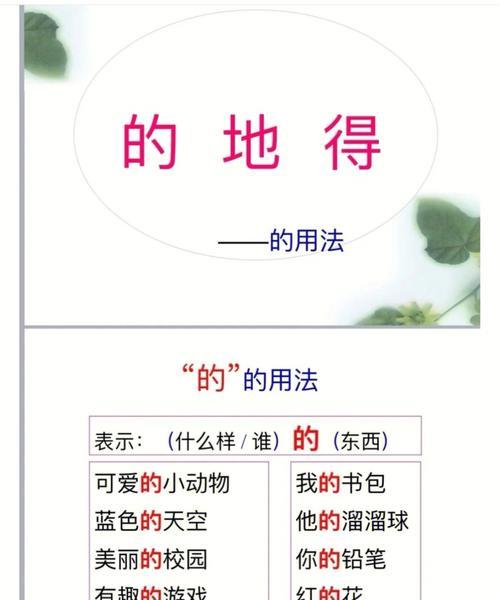“的”、“地”、“得”在句子中起不同的作用,“的”表示名词的修饰关系,如“美丽的花儿”,“地”表示副词的修饰关系,如“快乐地唱歌”,“得”表示动词的程度,如“跑得快”。此外,英语中的小词如“the”、“a/an”、“and”等在句子中也有各自的用法,如“the”用于特指某一事物,“a/an”用于泛指某一事物,“and”用于连接两个或多个单词或短语等。掌握这些词的用法有助于更好地理解和使用英语。

“的”、“地”、“得”的区别
许多初学者容易混淆“的”、“地”、“得”的用法。它们都是语气助词,但在句子中所起的作用各不相同。
- “的”:表示名词的修饰关系,用在形容词后面,如“美丽的花儿”。
- “地”:表示副词的修饰关系,用在形容词后面,如“快乐地唱歌”。
- “得”:表示动词的程度,用在动词前面,如“跑得快”。
常用小词及其用法
以下是一些常用的小词及其用法:
- the:定冠词,用于特指某一事物,如“The book on the table is mine.”(桌子上的书是我的。)
- a/an:不定冠词,用于泛指某一事物,如“A cat is on the roof.”(一只猫在屋顶上。)
- and:连词,用于连接两个或多个单词或短语,如“Apples and oranges are both fruits.”(苹果和橘子都是水果。)
- of:介词,表示所属关系,如“The cover of the book is red.”(书的封面是红色的。)
- to:介词,表示方向,如“I am going to the store.”(我要去商店。)
- in:介词,表示位置,如“The cat is in the box.”(猫在盒子里。)
- for:介词,表示目的,如“I bought flowers for my mom.”(我给妈妈买了花。)
- on:介词,表示位置,如“The book is on the table.”(书在桌子上。)
- at:介词,表示时间或位置,如“I will meet you at the park.”(我会在公园见你。)
- with:介词,表示陪伴或伴随,如“I am going to the movies with my friends.”(我和我的朋友一起去看电影。)
- by:介词,表示方法或手段,如“I go to work by bus.”(我乘公交车去上班。)
- from:介词,表示来源或出发点,如“I am from China.”(我来自中国。)
- about:介词,表示关于,如“This book is about animals.”(这本书是关于动物的。)
- as:连词,表示同等程度或方式,如“I like to run as much as I like to swim.”(我跑步和游泳一样喜欢。)
- into:介词,表示进入,如“The bird flew into the cage.”(鸟飞进了笼子里。)
- like:介词,表示类似,如“She looks like her mother.”(她长得像她妈妈。)
- through:介词,表示通过,如“We walked through the park.”(我们穿过了公园。)
- over:介词,表示覆盖或越过,如“The bridge goes over the river.”(桥梁跨越着河流。)
- before:介词,表示时间或顺序,如“I ate breakfast before I went to work.”(我上班前吃了早饭。)
- under:介词,表示位置或状态,如“The cat is under the bed.”(猫在床底下。)
- behind:介词,表示位置或状态,如“The car is behind the house.”(汽车在房子后面。)
- beyond:介词,表示远离或超出,如“The mountain is beyond the river.”(山在河的另一侧。)
- until:介词,表示时间,如“I will wait for you until you come back.”(我会等你回来。)
- within:介词,表示时间或范围,如“The project must be completed within two weeks.”(这个项目必须在两周内完成。)

